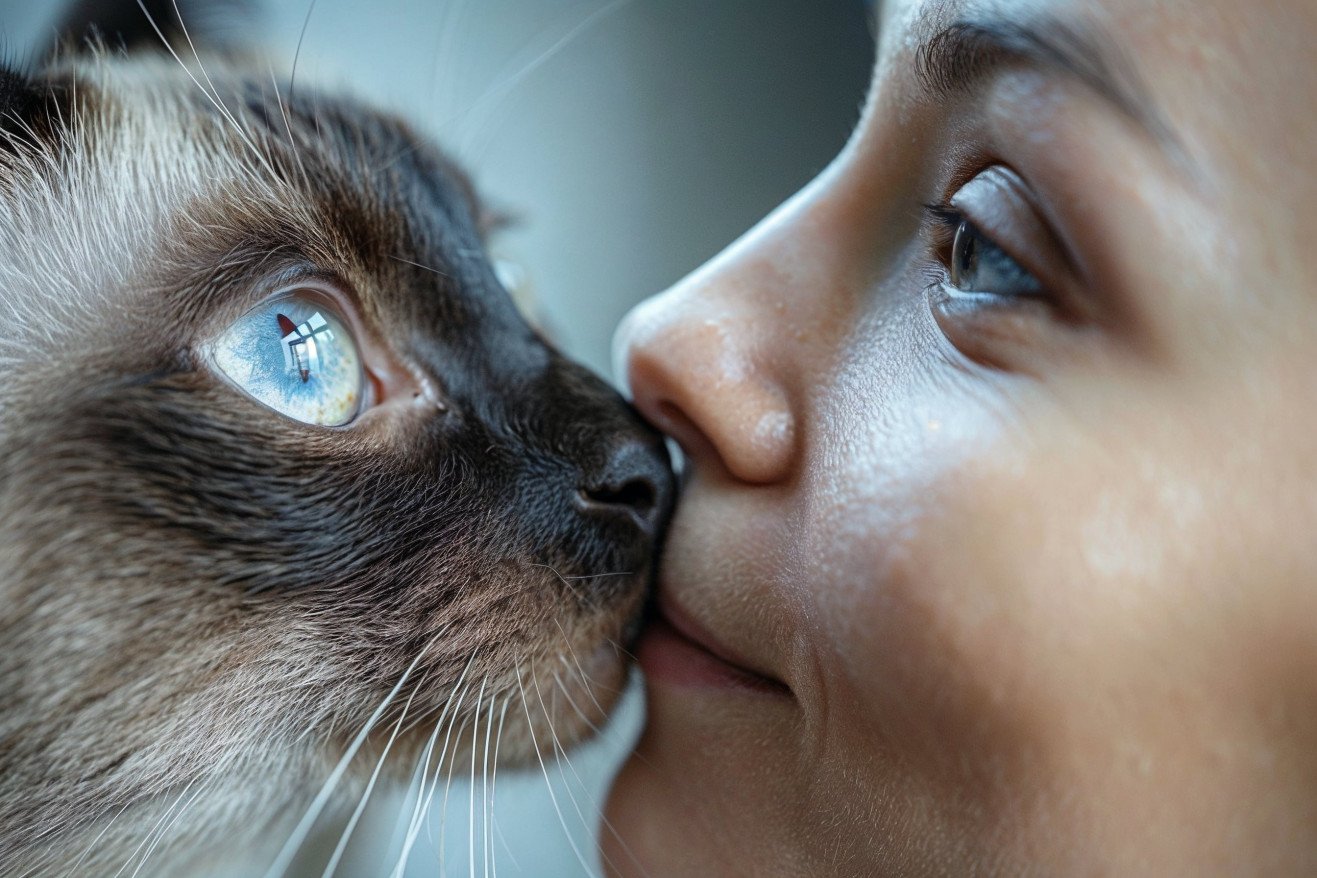Can Cats Smell Cancer? Exploring Their Remarkable Detection Abilities
19 April 2024 • Updated 17 April 2024

If you’ve ever seen your cat act weirdly around someone and wondered if cats can smell cancer, you’re not alone. Cats have an amazing sense of smell that’s between 14 and 100 times stronger than humans. Some researchers think that cats can smell the specific odor signatures of cells in the early stages of cancer due to their super sniffers. While more studies are needed to confirm this, there’s a lot of evidence to suggest that cats can smell cancer.
In fact, new research is now looking at how exactly cats can smell cancer and other diseases. In this article, we’ll take a deep dive into the most recent studies from biochemists, animal behaviorists, and oncologists that are looking at this amazing talent in our furry friends. This work may even lead to new methods of cancer detection and change our understanding of how well animals can smell.
Can cats smell cancer?
Why Do Cats Have Such a Good Sense of Smell?
Cats' sense of smell is much better than humans' due to a number of biological factors. According to a study cited by the NIH, cats have a much larger olfactory mucosa surface area of about 5.8 cm2, which is almost twice as large as humans'. They also have over 200 million odor-sensitive cells in their noses, while humans have only 5 million, according to Catster.
In addition, cats have a vomeronasal organ, also known as Jacobson's organ, that detects chemical signals, including pheromones. Some researchers think this organ may also help cats detect the chemical changes in the body that occur with diseases like cancer. Cats' ability to detect scents on a molecular level could potentially help them detect the presence of certain volatile organic compounds (VOCs) that are released by cancer cells.
Understanding the biological factors that contribute to cats' extraordinary sense of smell is important when it comes to investigating their ability to detect cancer and other diseases through scent. Cats' large olfactory mucosa, high number of odor-sensitive cells, and vomeronasal organ make them an interesting area of study for the potential of animal-based early disease detection. Their biological makeup provides a scientific explanation for the anecdotal evidence.
Anecdotal Evidence: Cats' Strange Cancer-Detecting Habits
Many people have reported that their cats started acting strangely, like cuddling more or licking a specific body part, before they were diagnosed with cancer. For example, a woman in Tennessee claimed that her cat helped her find her breast cancer after the cat started focusing on her chest and even caused a bruise to form in the area, which prompted her to get checked according to Catster. Meanwhile, a man in Alberta, Canada said his cat started pawing at his left side, which led to a checkup that revealed a tumor in his left lung also reported by Catster.
In some instances, the cats' behavior changed or went back to normal after the patient was treated, which could indicate that the cats were detecting the presence or absence of cancer. For example, as the PMC study points out, a patient's family noted that their cat, which had previously had surgery to remove a necrotic skin melanoma, showed "bizarre behavior" when the patient started showing signs of the disease, which stopped after the patient was treated.
While these reports are anecdotal, they offer real-world evidence that cats may be able to detect cancer through their sense of smell. However, further scientific research is necessary to confirm these observations and determine the biological and chemical processes that may allow cats to detect cancer odors.
Research on Cats' Ability to Smell Cancer
Some studies have been done to see if cats can tell the difference between urine samples from healthy people and those with cancer. For example, one study by the PMC used a nematode (C. elegans) to analyze chemotaxis responses to urine samples from cats with and without cancer and found that there were differences. Specifically, the chemotaxis index for feline urine samples was significantly different between healthy subjects and cancer patients at certain dilutions.
Another study looked at whether cats could be trained to detect cancer through scent, which is how cancer-sniffing dogs are trained. However, as Catster points out, cats are generally considered harder to train than dogs, which is why most research has focused on training dogs to detect cancer. The study found that training cats to detect cancer was indeed challenging.
While these studies suggest that cats may have the biological ability to detect cancer through their sense of smell, they are also very limited. As a result, more research is needed to better understand cats' ability to detect cancer and its potential uses, as the UW Veterinary Care website observes. This will include figuring out how to train and work with cats to detect cancer.
Hurdles and Drawbacks of Using Cats for Cancer Detection
Despite the biological potential for cats to detect cancer, there are several hurdles to training and using them for this purpose. As the PMC study mentioned above points out, cats are generally harder to train than dogs, which have been the focus of most research on cancer-detecting animals. The PMC study on COVID sniffer dogs also demonstrates the difficulty of training animals for medical detection, noting that the animals’ success rates often decrease when they move from the lab to the field.
There are also ethical issues associated with training cats to detect cancer, including the potential for stress and welfare problems, which are outlined by the European Medicines Agency. The agency stresses the importance of applying the 3Rs (Replacement, Reduction, and Refinement) and animal welfare standards to the use of animals in all medical research and development.
There are also practical limitations to using cats for cancer detection, including the need for specialized facilities and handlers. These obstacles make it clear that while cats’ olfactory skills are impressive, the rise of non-animal-based cancer detection and screening methods may make it possible to avoid using cats and other animals for this purpose.
Researching Alternative, Non-Animal-Based Cancer Detection Techniques
In light of the ethical and scientific concerns associated with using animals for medical purposes, including cancer detection, researchers are actively working to develop alternative, non-animal-based cancer detection and screening techniques. PETA reports that the most innovative scientists today are using human cells and tissues, cutting-edge computer-modeling technologies, and clinical and epidemiological studies on human volunteers to replace animals.
One example is organ-on-a-chip technology, which involves human cells being placed in a microfluidic system that replicates the structure and function of human organs. The Humane Society explains that these chips can replace animals in disease research, drug development, and toxicity testing and are more physiologically similar to humans than animal experiments. Another promising technology is 3D bioprinting, which can be used to create personalized in vitro models and may help reduce the need for animal models.
In addition, in silico models and artificial intelligence are enabling researchers to predict toxicity and other endpoints with the same accuracy as animal studies, sparing millions of animals. These human-based models and simulations can offer more accurate and human-relevant information for cancer research and the development of new diagnostics.
Although they are still in the works, these alternatives may eventually replace or supplement the use of animals like cats in cancer detection, providing a more ethical and scientifically sound solution.
Conclusion: The Future of Cancer Detection and Feline Olfaction
While more research is necessary, the current data indicates that cats have impressive olfactory skills that may enable them to detect cancer through smell. However, there are many challenges and limitations to using cats as cancer detectors, including problems with training and ethical considerations.
As technology progresses, there are more and more non-animal-based options for cancer detection and screening that may eventually make it unnecessary to use cats and other animals. Organ-on-a-chip models, 3D bioprinting, and artificial intelligence are some of the innovations that show promise for providing better, more accurate information for cancer research and the development of diagnostic tests.
No matter the method, more research and innovation in this area has the potential to lead to earlier and more accurate cancer detection, which would be a win for patients. While the olfactory skills of cats are impressive, the future of cancer detection is likely to be found in human-based technology and models.


